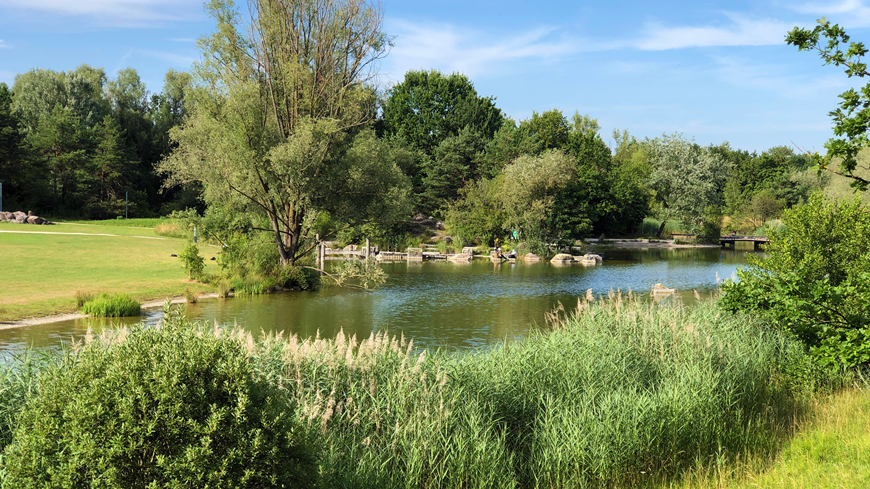Coping with stress in a noisy environment
Urban green spaces are islands of relaxation
It is hardly surprising that green spaces in noisy cities offer people respite from stress. However, a comprehensive study by Empa and WSL shows for the first time for Switzerland how much these recreational spaces actually affect physical and mental stress management.

More and more people are moving to cities, which means more traffic, denser living and less space for parks or other green areas. As a result, the urban population is exposed to more and more noise and has fewer opportunities to relax in natural environments. A study by Empa and the Swiss Federal Institute for Forest, Snow and Landscape Research (WSL), funded by the Swiss National Science Foundation (SNSF), now shows how great the potential of urban green spaces for stress management actually is. “Noise-stricken city dwellers can recover much better if they live near green spaces or in green environments. This effect can be seen on both a physical and mental level - and is even demonstrable in the long term,” says Empa researcher Beat Schäffer, summarizing the main findings. “The negative impact of noise on people can therefore be compensated to a certain extent by green spaces.”
Stress test in the laboratory

So far, a lot of research has been done on the negative effects of noise, but hardly any on the positive influence of green spaces. In order to investigate the short-term effect on stress management, the researchers used the audiovisual environment of Empa's auralization laboratory (“AuraLab”). The test subjects were initially stressed - in the laboratory they had to solve tasks under time pressure while being exposed to traffic noise at three different volumes (35 to 75 dBA, comparable to the background noise of a reading room through to loud road traffic).
After the stress phase, they were immersed in a virtual world using VR goggles: either in an urban environment with quiet city noises or in a landscape in the countryside with a natural background noise (44 dBA in each case, similar to the volume in a living room). The researchers created these audiovisual scenarios using a 360-degree camera and a so-called ambisonic microphone - at various locations in the city of Zurich with varying degrees of greenery and different background noises.
After immersing themselves in the virtual green space, the test subjects felt calmer, more relaxed and more focused than in the urban comparison scenario. “At the beginning, there was a relaxation effect during both VR scenarios, but ultimately the physical stress decreased significantly more in the green environment,” explains Empa researcher Claudia Kawai. The physiological stress level was measured by the sweat production on the fingers and the cortisol concentration in the saliva. The researchers were able to prove the negative effect of stress on the body through increased skin conductivity due to increased sweat secretion. However, these physical stress symptoms only occurred when the test subjects were not only exposed to noise in the stressful situation, but also had to solve tasks at the same time. Traffic noise, on the other hand, was always perceived as annoying, regardless of the additional cognitive stress.
Visit at home
The results from the laboratory were also confirmed in a field study. Empa researchers visited more than 230 volunteers in the city of Zurich who live in environments with varying degrees of noise pollution and greenery. They documented the participants' surroundings with photos, took hair samples to measure the stress hormone cortisol and asked them how they felt. “Both the interviews and the laboratory analyses of the hair samples showed that green spaces in the neighborhood actually promote relaxation,” says Beat Schäffer. The restorative effect of green spaces is therefore not only short-term, but also reduces long-term stress.
In addition, WSL researchers conducted a representative survey to determine how well the Swiss population can relax in the green spaces in their neighborhoods and what role noise pollution plays in this. On accompanied walks, they also investigated which audiovisual features are particularly conducive to relaxation. The results of the four sub-studies are now being combined to determine the recreational potential of green spaces. According to Empa researcher Schäffer, this so-called RESTORE project (“Restorative green spaces in noise-polluted areas”) is unique and addresses a relevant topic that affects three quarters of the urban population in Europe. “It will provide important information for legislators and spatial planners and influence Swiss noise legislation and the implementation of the revised Spatial Planning Act.”
Dr. Beat Schäffer
Acoustics/Noise Control
Phone +41 58 765 4737
Green technology
Wood is the raw material of the future. It is abundant in Switzerland, is renewable and binds carbon dioxide as it grows. And it is much more versatile than you might think. Empa researchers make wood glow or produce “green electronics” from cellulose fibers, for example environmental sensors or even batteries. They are also analyzing and optimizing the use of wood in Switzerland so that we can use this natural material as sustainably and climate-effectively as possible in the future.
Read the latest EmpaQuarterly online or download the PDF version.
-
Share






